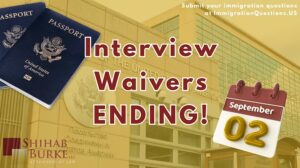
On January 21, 2022, the Departments of State and Homeland Security announced new policies with the goal of attracting and retaining more STEM talent to the US. Below is an explanation of the key changes and clarifications.
F-1 OPT/STEM OPT Extensions
The Department of Homeland Security published a notice on the Federal Register announcing their plan to add twenty-two new qualifying fields of study to the Degree Program List for Science-Technology-Engineering-Mathematics (STEM) Optional Practical Training (OPT). This expansion is significant because STEM OPT plays a vital role in F-1 student visa holder’s ability to gain work experience and potentially further their life and career in the United States.
After obtaining their U.S. degree, many students wishing to obtain employment in the U.S. utilize the H-1B temporary work visa program. However, the number of H-1B visas available is capped and there are far more applicants than visas available for the last several years. Accordingly, the government randomly selects (H-1B CAP lottery) who is picked for such a visa, resulting in many U.S. graduates running out of time in the U.S.
However, an F-1 student can use the OPT program, after completing their degree in the U.S., which allows the student to remain and work in the U.S. for one more year (and thus try his or her luck in the H-1B CAP lottery). Students with a qualifying STEM degree can then extend for 2 more years to complete temporary training as long as the training directly relates to the student’s qualifying field of study (i.e. 2 more chances in the H-1B CAP lottery).
The Department of Homeland Security asked interested parties to submit suggestions for fields of study that should be added or removed from the qualifying list. To determine if a degree field qualifies for STEM OPT, DHS has designated four fields which are generally considered to be STEM fields: engineering, biological and biomedical sciences, mathematics and statistics, and physical sciences. If a field is already included as a sub-field of one of the four major STEM fields, then it is automatically included. However, if a newly proposed field does not fall under the four major STEM fields, an evaluation is made to determine if it should be included.
A degree field is generally considered to be STEM if it is recognized as a STEM degree by the proper authorities. Evaluators also consider the opinions of educational institutions, governmental groups, and non-governmental organizations.
The new qualifying fields are:
- Bioenergy
- Forestry, General
- Forest Resources Production and Management
- Human-Centered Technology and Design
- Cloud Computing
- Anthrozoology
- Climate Science
- Earth Systems Science
- Economics and Computer Science
- Environmental Geosciences
- Geobiology
- Geography and Environmental Studies
- Mathematical Economics
- Mathematics and Atmospheric/Oceanic Science
- Data Science, General
- Data Analytics, General
- Business Analytics
- Data Visualization
- Financial Analytics
- Data Analytics, Other
- Industrial and Organizational Psychology and Social Sciences
- Research Methodology and Quantitative Methods
Because of the H-1B CAP lottery system where selection (and potentially, therefore, the student’s ability to stay in the U.S.) cannot be guaranteed, the expansion of the STEM OPT Degree Program List could be an important step toward many F-1 students’ ability to gain temporary employment in the United States through an H-1B petition.
O-1A Policy Manual Updates (Clarifying eligibility and evidentiary requirements)
The Department of Homeland Security updated its policy manual, providing increased clarity on the eligibility and evidentiary requirements pertaining to O-1A nonimmigrant visas. Generally, O-1A visas are available to individuals of “extraordinary ability” in science, business, education, or athletics. This most recent update gives examples of evidence that can satisfy the O-1A evidentiary requirements. Specifically, this update pertains to STEM O-1A visas.
To show that one has an “extraordinary ability” in STEM, one most show they have sustained national or international acclaim, recognized achievement evidenced by extensive documentation, and will be working in their area of extraordinary ability. The acclaim and achievement prongs can be evidenced by the beneficiary receiving an international award.
Awards that qualify under this category include, but may not be limited to: awards from national institutions and professional associations, dissertation awards and Ph.D. scholarships. To determine if the award qualifies, USCIS considers the criteria for the specific award or prize, the national or international significance, and the limitations on the eligible competitors. Essentially, USCIS considers the prestige and the competitive nature of the award.
The policy update expands on qualifying evidence for the other O-1A requirements as well. Membership in related associations that require certain level of achievement can count as fulfilling the O-1A requirement. This includes membership in certain professional associations or fellowships with certain institutions. For the membership to fulfill the O-1A requirement, the petitioner must be able to show that the membership to the organization requires outstanding achievements in their field.
Indications that membership is not based on outstanding achievement include admission to the organization based solely on education or experience, paying a fee or subscribing to their publications, or a requirement of membership for employment, like union membership.
Publication in a major trade publication or media publication relating to the beneficiary’s field may also count as evidence of one’s extraordinary ability in their field. The publication or media does not need to be solely about the beneficiary’s work; however, it must contain a “substantial discussion” about the beneficiary’s work if it encompasses multiple subjects.
Membership on a panel or as a judge in the related field may count towards eligibility, too. This can be reviewing scholarly papers, being a member of a doctoral dissertation committee, peer reviewing for a publication, etc. However, the petitioner must be able to show that the beneficiary was an active participant in their judgment or review of others’ work and that work is in a related field to theirs.
Further, publications that relay the significance of the beneficiary’s original work can demonstrate extraordinary ability. The main requirement is that the beneficiary’s work must constitute a major, significant contribution to their field. This can be shown through publication that had a widespread impact on the field or has been highly cited by others in the field. Patented technology also tends to show the significance and originality of one’s contribution to their field.
Finally, authorship of publications or articles, employment in a critical role within a distinguished organization, or evidence that the beneficiary has or will receive a high salary (relative to others in their field) can be used as evidence of their extraordinary ability.
As evidenced above, there are many ways to show extraordinary ability—the key is to do so with abundant and strong evidence, and by demonstrating eligibility in as many of the listed criteria as possible.
National Interest Waiver
For many employment-based green cards, the Beneficiary must first have an employer-petitioner offer a permanent job and then go through the Labor Certification process. This process is designed to show that there are no qualified U.S. workers for the position being offered.
However, the Immigration and Nationality Act (INA) allows for waiver of these requirements professionals with an advanced degree or those of exceptional ability when USCIS deems that to be in the national interest. Accordingly, the National Interest Waiver allows some foreign nationals to skip the Labor Certification process or petition on their own behalf. USCIS has published a policy alert to clarify how STEM graduates and entrepreneurs can use the national interest waiver.
Generally, to be eligible for the waiver as an advanced degree professional, the beneficiary must be a member of the profession they hold the advanced degree in, the certified position must be one that requires the professional to hold an advanced degree, and the beneficiary had the advanced degree and met all requirement for the position at the time the Labor Certification was filed.
To be eligible for the waiver as an immigrant with exceptional ability, the beneficiary must show they have exceptional ability in the sciences, arts, or business, they will substantially benefit the national economy, cultural/educational interests, or welfare of the U.S. in the future, and their services are sought by an employer in the U.S. Generally, exceptional ability is considered expertise that is significantly above ordinary ability, but lower than extraordinary ability.
Initial evidence of one’s exceptional ability must include at least three of the following: an academic record showing the beneficiary has a degree, award, or certificate relating to their field of exceptional ability, experience letters from employers showing ten years of experience in the specific occupation, a license to practice in that occupation, evidence of a salary that is indicative of exceptional ability, membership in professional associations, and achievements and significant contributions to the industry.
The updated guidance from USCIS recognizes the importance of emerging STEM fields. Factors that strongly support granting a waiver include possession of an advanced STEM degree, specifically a Ph.D., working in a position that will further critical and emerging technology (or any other STEM field deemed important to U.S. competitiveness), and the person is able to advance the proposed STEM endeavor.
Early Career STEM Research Initiative
Like the goal of the STEM OPT expansion, new guidance from the Department of State’s Bureau of Educational and Cultural Affairs allows for additional academic training for undergraduate and graduate (non-Ph.D.) students on J-1 visas. Specific to STEM-related studies, J-1 visa students can now receive a total of thirty-six months of academic training, which is double the previous limit of eighteen months. The goal is to create more STEM opportunities for international students in the U.S.
How We Can Help
These updates to STEM related immigration policies are a step in the right direction for U.S. technological advancement and economic competition and retaining talent here in the U.S. While the increased guidance is helpful and necessary, these can still be complicated cases and petitions.
If you are an international student or a recent graduate – or a U.S.-based employer – don’t wait. Contact us today to speak with a skilled and diligent Ohio immigration attorney about the immigration-related legal advice and services you need.









